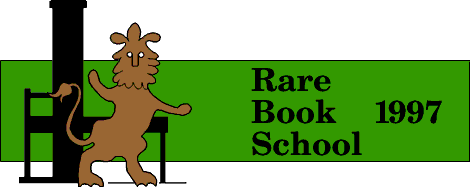46 Introduction to
Electronic Texts and Images. See the ECD for
course no. 26. Return to
course descriptions.
A Brief Description of Rare Book School
Terry Belanger founded RBS in 1983 at Columbia University under the
aegis of the Book Arts Press (BAP), the bibliographical laboratory he
established at the School of Library Service in 1972 to support the
study of the history of the book. The first RBS offered eight five-day
courses on subjects similar to those still offered today similar and,
indeed, in some case identical: seven of the fifteen living RBS 1983
instructors Sue Allen, Nicolas Barker, TB, Christopher Clarkson, Paul
Needham, Daniel Traister, Michael Turner, and Michael Winship still
regularly teach in the institute. The eight original courses (two
courses per week held over a four-week period) were all team-taught,
because TB was then under the impression that no single instructor
could teach a highly specialized subject, six hours a day, for five
days straight.
RBS 1983 was a considerable success: with [8 x 15 =] 120 places
available, 112 students attended. Our lion (derived from an early C 19
watermark) made his first appearance as a trademark at RBS 1984, which
expanded to 20 courses. Over the years, the institute has continued to
grow and prosper; RBS 1997 offers 24 courses, mostly with single
instructors (who teach 12 or fewer students four to six hours a day
for five days straight).
In 1993, RBS moved from New York to the University of Virginia, where
some of the BAP's teaching collections are almost always on display in
the Dome Room of the Rotunda on The Lawn, on the central grounds of
the University. These collections have grown enormously in recent
years, in large part thanks to the generosity of the BAP's 600-member
support group, the Friends of the Book Arts Press.
In New York and Charlottesville, a typical RBS student experience has
emerged. (Most RBS students are, of course, not students: they tend to
be working professionals who sometimes have students of their own,
back home.) RBS attendees usually enroll for a single course in any
given summer. They generally arrive on Sunday in time for housing
check-in, a tour of the Grounds, registration, a reception, and an
opening dinner followed by the showing of videotapes and films on
bibliographical subjects. Classes begin on Monday morning; each day is
divided into four 90-minute classroom sessions punctuated by lunch and
by half-hour morning and afternoon coffee breaks. The intensity of RBS
coffee breaks must be observed to be believed. At six pm on Monday and
Wednesday evenings, there is generally a public lecture on a subject
of bookish interest, followed by a reception. Tuesday is usually
Bookseller Night, with students encouraged to visit local used and
antiquarian bookshops, and take advantage of Charlottesville's many
excellent restaurants. On Thursday evening, TB speaks about the BAP,
RBS, and whatever else is on his mind at the moment; his lecture is
followed by a Director's Reception in the Book Arts Pressroom at which
(as an incentive) there is generally more food to be found than at the
Monday and Wednesday night receptions. Classes end on Friday with
evaluations (a very important part of the RBS week) followed by a
closing reception. Most students stay in residence at least over
Friday night (they may use RBS housing as long as they wish), in part
to avoid the annoyances inherent in Friday evening travel, and in part
to have a final dinner with new and old friends and acquaintances:
about half of RBS students in any given week are returnees from
previous years.
In striving for excellence, it is not always possible to be
comfortable; still, RBS tries very hard indeed to offer its faculty
and students alike an experience that is both worthwhile and
enjoyable. We were pleased by a comment in a RBS 1994 course
evaluation that described Rare Book School as "an intellectual
Hawaii."

